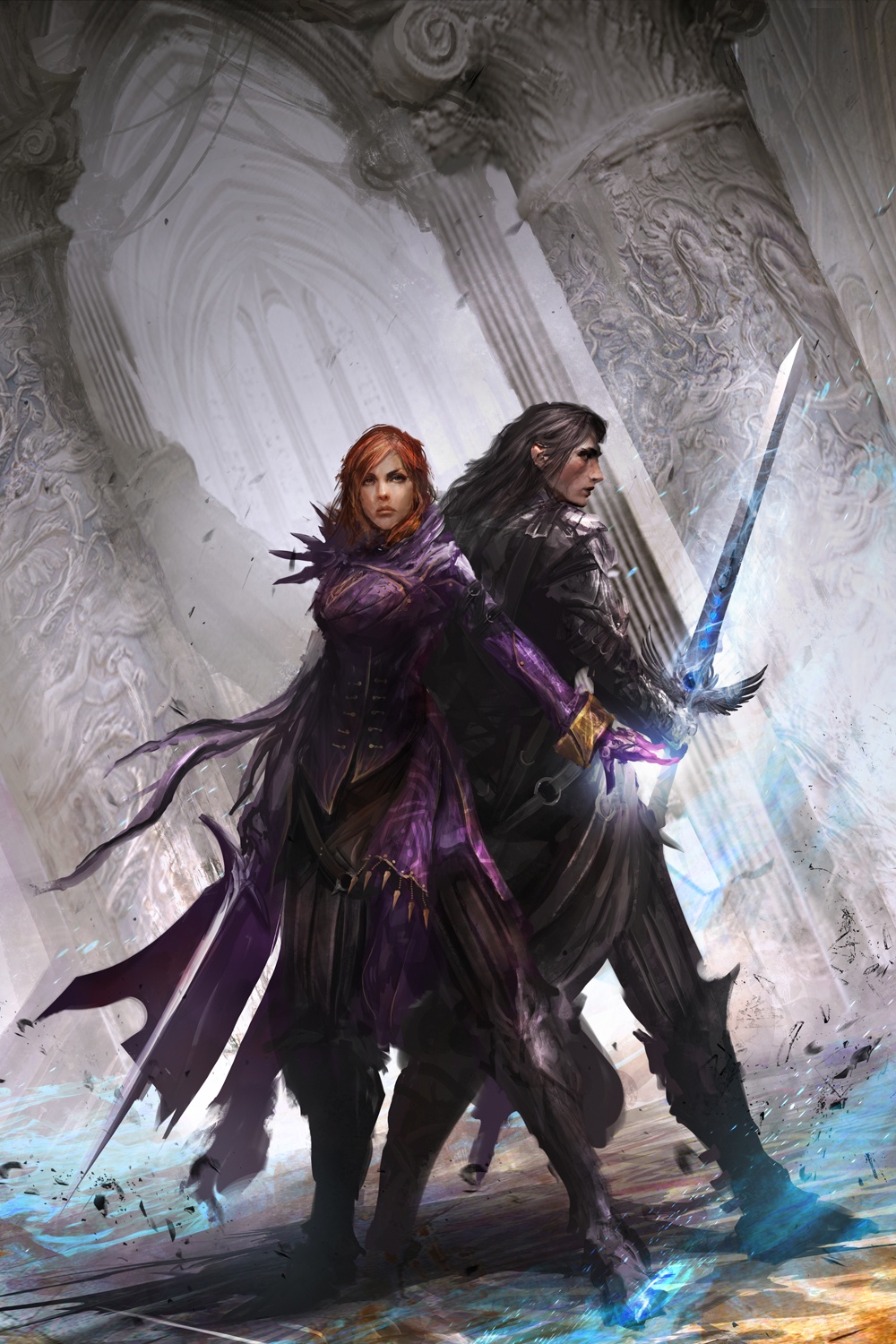
Magus
A half-elf, wielding her signature curved blade, strides towards the orc raiding party. As the nearest orc prepares to deflect the anticipated strike, the elf waves her hand causing the blade to ignite with flame. She deftly brings her blade down as the fire engulfs her target.
A human scholar spends days poring over countless tomes of ancient secrets and combat styles from unknown lands. Finally, he grins as he is hit with an epiphany. Grabbing his hand axe and whirling it in a defensive posture, lightning crackles from the spinning metal. His research complete, he seeks out a worthy opponent.
A tiefling in dark leathers peers from a rooftop under the cover of darkness. He whispers an incantation under his breath, as shadows engulf his quarry's eyes below. The blinded target is unable to avoid the plunging blade.
All of these heroes are magi. Though individual magi are as diverse as weapons and spells, all magi combine the martial prowess of fighters with the arcane power of wizards. Devoting their lives to the study of both schools, magi combine blade and arcana with devastating effect. Many are naturally drawn to adventure often seeking the chance to perfect their craft or use their skills to benefit themselves or others.
Might and Magic
There are those who spend their lives poring over ancient tomes and texts, unlocking the power of magic, and there are those who spend their time perfecting the use of individual weapons, becoming masters without equal. The magus is at once a student of both philosophies, blending magical ability and martial prowess into something entirely unique, a discipline in which both spell and steel are used to devastating effect. As magi grow in power, they unlock powerful forms of arcana that allow them to merge their talents further, and at the pinnacle of their art, magi become
a blur of steel and magic, a force that few foes would dare to stand against.
Versatile Students
Magi spend much of their time traveling the world, learning whatever secrets they can find. They might spend months learning a new sword-fighting style from a master warrior, while simultaneously moonlighting in the local library, poring through tomes of ancient lore. Most who take this path dabble in all sorts of knowledge, picking up anything that might aid them in their search for martial and magical perfection.
Creating a Magus
To create a magus, consider what drives your character to develop their martial and magical prowess. Did something happen to a loved one, instilling in you a need to protect others? Do you have a rival, whom you must prove inferior? Do you come from a family or tradition that expects absolute perfection in the art of combat?
As a magus gains power, they refine their focus into a particular magi study. Although the class features related to your study don’t appear until you reach 3rd level, plan ahead for that choice by reading the study descriptions at the end of the class. Are you a heavily-armored warrior, using magic to supplement your powerful strikes? Are you a student of witchcraft, using your arcane energies to curse and control others? Or are you a devoted servant of a diety, trained to purge evil from the land?
Finally, consider your motivations for pursuing adventure. Are you adventuring to improve your mastery of martial combat or arcane knowledge? To use your abilities for good? Or maybe to prove yourself to your mentor or a parent figure?
Quick Build
You can make a magus quickly by following these suggestions. First, Strength or Dexterity should be your highest ability score, followed by Intelligence. Second, choose the sage background. Third, choose
the fire bolt and shocking
grasp cantrips.
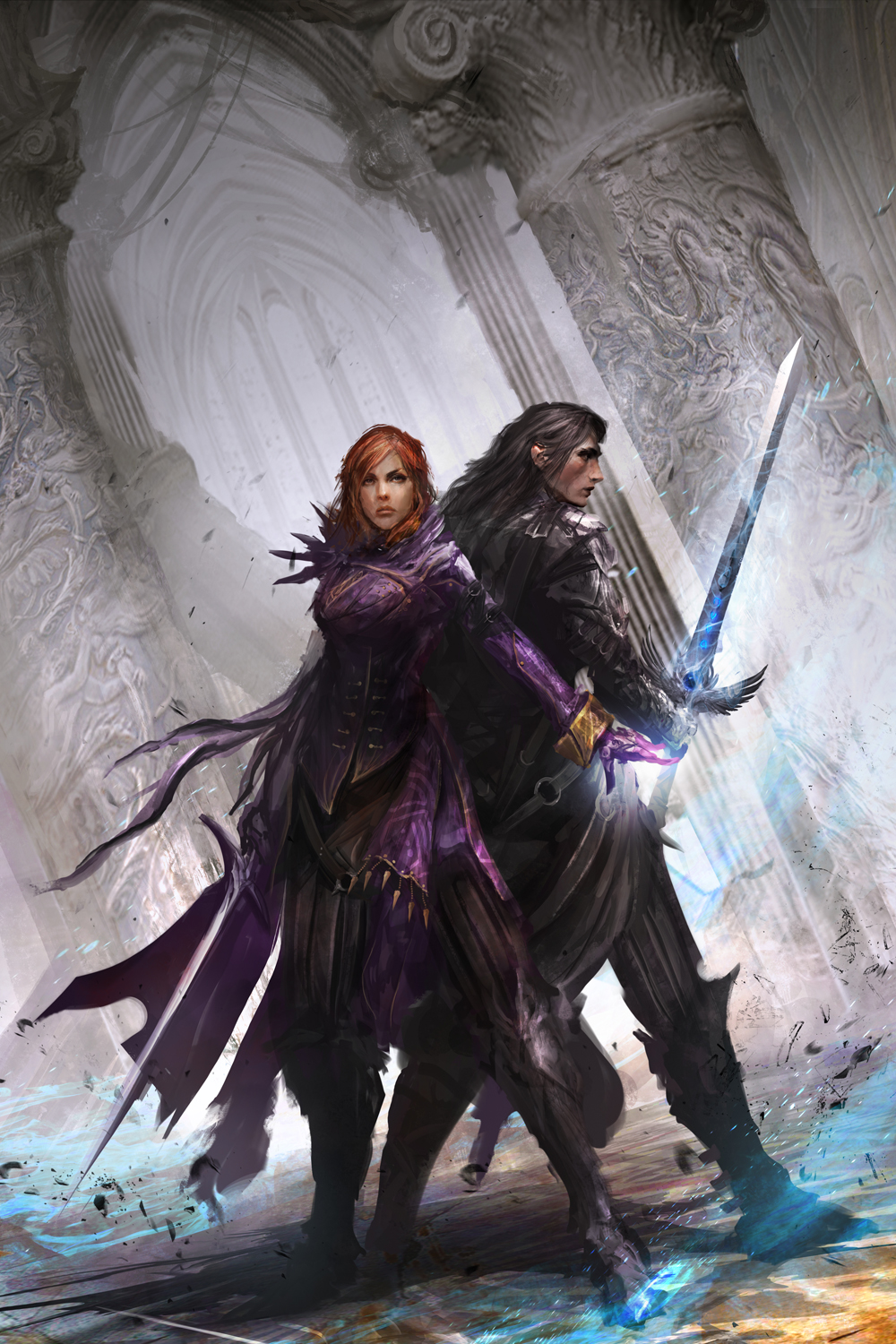


















The Magus Table
| Level | Proficiency Bonus |
Features | Arcana Points |
Cantrips Known |
1st | 2nd | 3rd | 4th | 5th |
|---|---|---|---|---|---|---|---|---|---|
| 1st | +2 | Spellcasting (Cantrips), Spellstrike | - | 2 | — | — | — | — | — |
| 2nd | +2 | Spellcasting (Spell Slots), Magus Arcana (2) | 2 | 2 | 2 | — | — | — | — |
| 3rd | +2 | Magus Study, Spell Recognition | 3 | 3 | 3 | — | — | — | — |
| 4th | +2 | Ability Score Improvement | 4 | 3 | 3 | — | — | — | — |
| 5th | +3 | Extra Attack | 5 | 4 | 4 | 2 | — | — | — |
| 6th | +3 | Magus' Shield | 6 | 4 | 4 | 2 | — | — | — |
| 7th | +3 | Magus Study Feature | 7 | 4 | 4 | 3 | — | — | — |
| 8th | +3 | Ability Score Improvement | 8 | 4 | 4 | 3 | — | — | — |
| 9th | +4 | — | 9 | 4 | 4 | 3 | 2 | — | — |
| 10th | +4 | Magus Arcana (2), Arcane Knowledge (2) | 10 | 4 | 4 | 3 | 2 | — | — |
| 11th | +4 | Magus Study Feature, Improved Spellstrike | 11 | 4 | 4 | 3 | 3 | — | — |
| 12th | +4 | Ability Score Improvement | 12 | 4 | 4 | 3 | 3 | — | — |
| 13th | +5 | — | 13 | 4 | 4 | 3 | 3 | 1 | — |
| 14th | +5 | Spell Absorption, Arcane Knowledge (1) | 14 | 4 | 4 | 3 | 3 | 1 | — |
| 15th | +5 | Magus Study Feature | 15 | 4 | 4 | 3 | 3 | 2 | — |
| 16th | +5 | Ability Score Improvement | 16 | 4 | 4 | 3 | 3 | 2 | — |
| 17th | +6 | — | 17 | 4 | 4 | 3 | 3 | 3 | 1 |
| 18th | +6 | Magus Arcana (2), Arcane Knowledge (1) | 18 | 4 | 4 | 3 | 3 | 3 | 1 |
| 19th | +6 | Ability Score Improvement | 19 | 4 | 4 | 3 | 3 | 3 | 2 |
| 20th | +6 | True Magus | 20 | 4 | 4 | 3 | 3 | 3 | 2 |
Class Features
As a Magus, you gain the following class features:
Hit Points
- Hit Dice: 1d8 per magus level
- Hit Points at 1st Level: 8 + your Constitution modifier
- Hit Points at Higher Levels: 1d8 (or 5) + your Constitution modifier per magus level after 1st
Proficiencies
- Armor: Light armor, medium armor
- Weapons: Simple weapons, martial weapons
- Tools: None
- Saving Throws: Dexterity, Intelligence
- Skills: Choose two skills from Acrobatics, Athletics, Arcana, History, Investigation, Religion
Equipment
You start with the following equipment, in addition to the equipment granted by your background:
- A martial melee weapon
- (a) a chain shirt or (b) leather armor
- (a) a component pouch or (b) an arcane focus
- (a) a scholar’s pack or (b) an explorer's pack
Spellcasting
As a student of arcane magic and martial technique, you commit spells to memory for use even while engaged in combat. See the magus spell list for the spells you can learn.
Cantrips
At 1st level, you know two cantrips of your choice from the magus spell list. You learn additional magus cantrips of your choice at higher levels, as shown in the Cantrips Known column of the Magus table.
Spell Slots
The Magus table shows how many spell slots you have to cast your magus spells of 1st level and higher. To cast one of these spells, you must expend a slot of the spell’s level or higher. You regain all expended spell slots when you finish a long rest.
Spells Known of 1st Level and Higher
At 2nd level, you learn two 1st-level spells of your choice from the magus spell list. Each time you gain a Magus Level, you may learn one magus spell and replace one of the magus spells you know with another spell of your choice from the magus spell list. Each of these spells must be of a level for which you have spell slots, as shown on the Magus table.
Spellcasting Ability
Intelligence is your spellcasting ability for your magus spells. You use your Intelligence whenever a spell refers to your spellcasting ability. In addition, you use your Intelligence modifier when setting the saving throw DC for a magus spell you cast and when making an attack roll with one.
Spell attack modifier = your proficiency bonus +
Spellcasting Focus
You can use an arcane focus as a spellcasting focus for your magus spells.
Spellstrike
At 1st level, you learn to deliver magical spells through melee attacks. Once per round, when you perform a melee attack and before you roll to hit, you may additionally cast a magus spell as part of the attack action by expending a spell slot of the spell's level or higher.
After choosing a spell, roll to hit as if attacking normally with your weapon. On a hit, the target suffers the weapon damage as well as the spell's effects. If the spell requires a saving throw, the target makes its initial save at disadvantage. On a miss, no weapon damage is dealt and the spell has no effect. On a critical hit, both the weapon damage die and any spell damage die are rolled twice and added together.
Spellstrike Rules:
- Spell Action: Spells used in spellstrike must have a casting time of 1 action or bonus action and must not normally require making a weapon attack.
- Cantrips: Cantrips can be cast as part of spellstrike and do not require a spellslot to be expended. However, cantrips cast this way deal damage as if cast by a character of levels 1-4.
- Area of Effect/Multiple Targets: Spells that affect an area or multiple targets instead only affect the creature targeted with spellstrike.
- Somatic Component: Spells with a somatic component may be cast with spellstrike while wielding a two-handed or versatile weapon in both hands, or a single weapon in each hand.
Magus Arcana
At 2nd level, you learn to weave martial prowess with arcane mastery, with hybrid abilities called "Magus Arcana." You know two such abilities. When you reach levels 10 and 18, you learn two more Arcana.
You may gain multiple features that allow you to spend AP when you successfully hit a creature. Only one such feature may be used on each hit.
Arcana Points
Magus Arcana cost Arcana Points (AP) to use. You have a number of Arcana Points equal to your Magus level. Expended AP are replenished after you complete a short or long rest.
Magus Arcana List
- Arcane Accuracy. As a bonus action, you may spend 1 AP to give yourself advantage on weapon attack rolls until the end of your turn.
- Critical Arcana. When you critically hit with a weapon attack, you may use your reaction and spend 2 AP to stun the target until the end of your next turn.
- Hastened Arcana. When you cast a spell with a casting time of one action, you may spend 3 AP to cast it as a bonus action instead. Any additional spells cast on your turn must be cantrips with a casting time of one action.
- Arcane Rebuke. As a reaction, when you take damage from an attacker that you can see, you may spend 2 AP to cast a cantrip against that attacker.
- Arcane Dodge. You can spend 1 AP to take the dodge action as a bonus action.
- Elementalist Arcana. As a bonus action, you can spend 1 AP to add your Intelligence Modifier to your weapon damage (as cold, fire, or lightning) until the end of your turn.
- Arcane Vigor. As a bonus action, spend 2 AP to gain temporary HP equal to double your Intelligence modifier.
- Arcane Guise. As a bonus action, you can spend 1 AP to add your Intelligence modifier to Stealth and Deception checks you make for 1 minute.
- Arcane Zeal. You can spend 1 AP to add your Intelligence modifier to the result of an initiative roll you make.
- Arcane Flow. When casting a spell that requires you to make an attack roll, you may use your bonus action and spend AP equal to 1 + the level of the spell cast (1 AP for cantrips) to target an additional creature either within 5 feet of you or the initial target.
Magus Study
At 3rd level, you focus your research and practice to a refined Magus Study. The study you choose grants you features at levels 3, 7, 11, and 15.
The studies of the Warmage, Magister, Hexcrafter, Eldritch Archer, Devoted Slayer, Stygian, and Primagus are shown below.
Spell Recognition
Beginning at 3rd level, you quickly recognize magic even in the heat of combat. You know the school of magical spells and effects that target you, that you are in the area of effect of, or that otherwise affect you.
This feature does not apply if you are unaware that you are under the influence of a spell or effect, such as when you are charmed or believe an illusion. If you become aware of the spell, you know its school of magic.
Ability Score Improvement
When you reach 4th level, and again at 8th, 12th, 16th, and 19th level, you can increase one ability score of your choice by 2, or you can increase two ability scores of your choice by 1. As normal, you can’t increase an ability score above 20 using this feature.
Using the optional feats rule, you can forgo taking this feature to take a feat of your choice instead.
Extra Attack
Beginning at 5th level, you can attack twice,
instead of once, whenever you take the attack
action on your turn.
You can replace one of those attacks with a
cantrip (cast as if you were levels 1-4).
Magus' Shield
Beginning at 6th level, you can protect
yourself with magical energies. You gain
proficiency in constitution saving throws made
to maintain concentration on spells when you
take damage.
Also, whenever you have a free hand, you gain
a +2 bonus to AC, as if you were wielding a
shield. You lose this benefit until the beginning
of your next turn if you use that hand to wield
a weapon or otherwise manipulate an
object.
Arcane Knowledge
At 10th level, you have expanded your arcane
knowledge to other disciplines. You may learn
two spells from any class list.
The chosen spells must be of a level for
which you have spell slots and count as magus
spells for you. You learn one more such spell at
levels 14 and 18.
Improved Spellstrike
At 11th level, you improve your ability to deliver
damaging cantrips with your weapon. Beginning
at this level, your damaging cantrips are treated as
if you are levels 5-10 when cast with the spellstrike
or extra attack features.
Spell Absorption
At 14th level, you learn to absorb harmful magical energies into your weapon. When you take damage from a magical spell or effect, you may spend 2 AP and use your reaction to reduce the incoming damage by 1d10 + your Intelligence modifier + your magus level.
The magical damage you absorbed is stored in your weapon and unleashed on your next hit. Before the end of your next turn, when you first hit a creature with your weapon, you deal additional damage equal to the amount avoided. The damage type is the same as the original triggering spell or effect.
Once you have absorbed magic into your weapon, you cannot use this feature again until the magic has been released through a successful attack or until it dissipates at the end of your next turn.
True Magus
At 20th level, you become a master of spells and combat. You may use the spellstrike feature twice per round if at least one of the spells used is a cantrip.
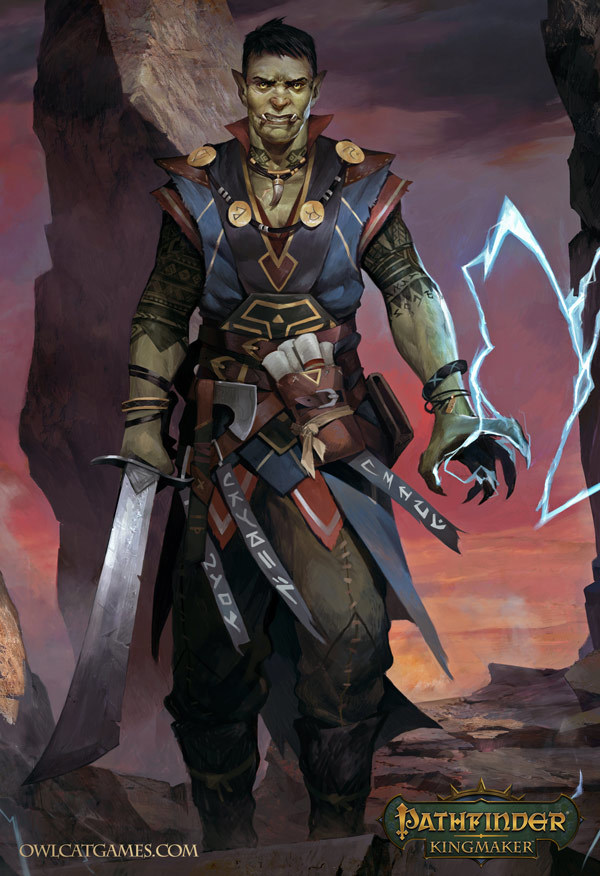






















Magus Studies
Magi have varied focuses and preferences regarding their magical and martial pursuits. These are grouped into "studies" representing the different approaches taken by magi.
Study of the Warmage
The warmage is a skilled specialist, using magic to supplement and augment their martial mastery. They are somewhat less inclined towards magical development than other magi, and instead seek supremacy with blade and armor.
Armor Bond
At 3rd level, when you choose this study, you gain proficiency in heavy armor.
In addition, you learn a ritual that creates a magical bond between yourself and one set of armor. You perform the ritual over the course of 1 hour, which can be done during a short or long rest. The armor must be within your reach throughout the ritual, at the conclusion of which you touch the armor and forge the bond. You can only bond with one set of armor at a time; to bond with new armor you must break your bond with the original armor as part of the ritual.
Once you have bonded armor to yourself, you no longer need to don and doff the armor as normal. Instead, as long as your bonded armor is on the same plane of existence, you can summon your armor as a bonus action on your turn, causing it to appear instantly on your body. Similarly, as a bonus action, you can dismiss the armor to a familiar location of your choice.
Warmage's Strike
Beginning at 3rd level, you can augment the damage of your weapon attacks with raw arcana. When you hit a creature with a weapon attack, you may spend AP to deal force damage equal to 1d6 per AP spent plus your intelligence
modifier. You may spend a number of AP up to half your
magus level (rounded down)
to use this feature.
Fighting Style
At 7th level, you adopt a particular style of fighting as your specialty. Choose one of the following options. You can’t take a Fighting Style option more than once, even if you later get to choose again.
Defense
While you are wearing armor, you gain a +1 bonus to AC.
Dueling
When you are wielding a melee weapon in one hand and no other weapons, you gain a +2 bonus to damage rolls with that weapon.
Great Weapon Fighting
When you roll a 1 or 2 on a damage die for an attack you make with a melee weapon that you are wielding with two hands, you can reroll the die and must use the new roll, even if the new roll is a 1 or a 2. The weapon must have the two-handed or versatile property for you to gain this benefit.
Protection
When a creature you can see attacks a target other than you that is within 5 feet of you, you can use your reaction to impose disadvantage on the attack roll. You must be wielding a shield or have increased AC from the magus' shield feature.
Arcane Sunder
Beginning at 11th level, your weapon strikes can undercut a creature’s resistance to spells. When you hit a creature with a weapon attack, you may spend 2 AP to give that creature disadvantage on the next saving throw it makes to resist a spell before the end of your next turn.
Mind and Body
At 15th level, you learn to use your extensive martial knowledge to give yourself an edge in physical activities. When you make a Strength, Dexterity, or Constitution ability check or saving throw, you may use your reaction to add your Intelligence modifier to the result. This can be done a
number of times per long rest
equal to your Intelligence
modifier (minimum
of once).
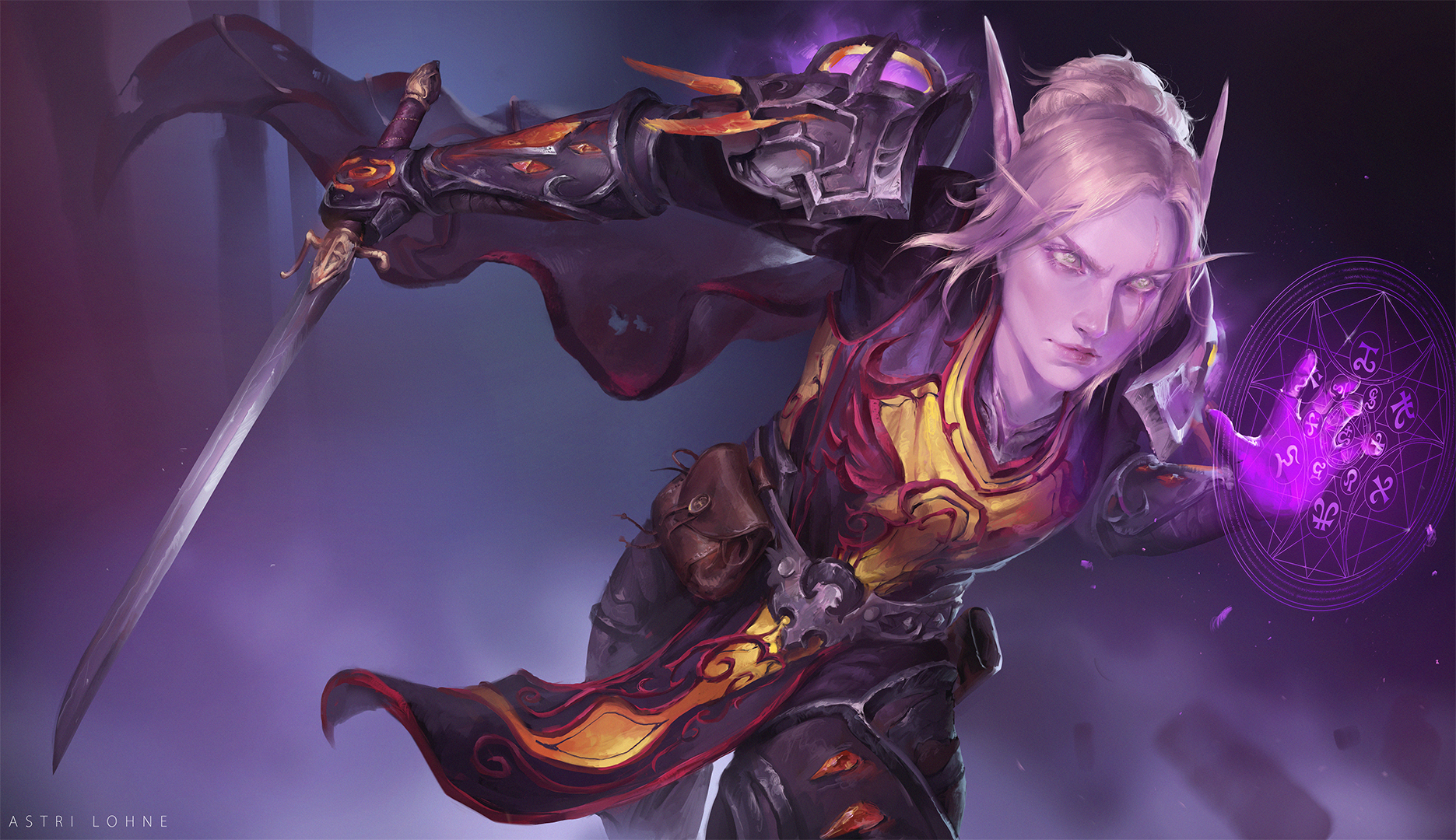
















Study of the Magister
In direct contrast to the warmage study, a magister
develops their spellcasting beyond that of the other magi studies. Magisters see the pursuit of arcane power as the ultimate means to perfection.
Arcana Flux
At 3rd level, you learn to bend your magical reserves to suit your purposes. You can use your arcane points to gain additional spell slots.
Creating Spell Slots. You can transform unexpended arcane points into one spell slot as a bonus action on your turn. The Creating Spell Slots table shows the cost of creating a spell slot of a given level. You can create spell slots no higher in level than 5th.
| Arcana Point Cost | Spell Slot Level |
|---|---|
| 2 | 1st |
| 3 | 2nd |
| 5 | 3rd |
| 6 | 4th |
| 7 | 5th |
Converting a Spell Slot to Arcana Points. As a bonus action on your turn, you can expend one spell slot and gain a number of arcane points equal to the slot’s level.
Font of Mana
Beginning at 3rd level, through practice you have developed your magical reserves further than most. You gain additional spell slots at the following levels. These replenish with your other spell slots.
- At 3rd level, you gain an additional level 1 Spell Slot.
- At 7th level, you gain an additional level 2 Spell Slot.
- At 11th level, you gain an additional level 3 Spell Slot.
Deep Arcane Knowledge
At 7th level, you learn two spells from any class list. The spells must be of a level for which you have spell slots and count as magus spells for you.
When you gain a magus level, you may replace one of the spells obtained with this feature for another.
Empowered Magic
Beginning at 11th level, you can empower your spells with arcane energy. You may spend 1 AP to add your Intelligence modifier to the damage of a magus spell you cast.
Arcane Restoration
Beginning at 15th level, once per short rest, you may replenish an amount of AP up to your Intelligence Modifier as a bonus action. At any time, your current AP cannot exceed your maximum AP pool.












Study of the Hexcrafter
A hexcrafter magus has uncovered the secret of using their arcane pool to recreate witch hexes. These magi can hex foes, curse those they strike, and expand their spell selection to include many curses and harmful spells.
Expanded Hexcrafter Spell List
You gain access to the following spells, and may learn them after you have reached the appropriate Magus level. They are magus spells for you.
| Magus Level | Spells |
|---|---|
| 3rd | hex, bane |
| 5th | enthrall, crown of madness |
| 9th | remove curse, bestow curse |
| 13th | blight, compulsion |
| 17th | geas, circle of power |
Cursed Blade
At 3rd level, you learn to curse
your weapon to debilitate and
harm your opponents. You
learn a ritual that turns a
weapon of your choice into
a cursed item. The ritual is
performed over 1 hour
which can be done during a
short or long rest.
You can handle the cursed
weapon without incurring any
negative effect, but any other
creature who wields the
weapon must make a wisdom
saving throw against your
spell save DC. On a failure, they
must make a roll on the short-term
madness table (located in the dungeon
master's guide). Anytime the creature
attempts a weapon attack with the cursed
weapon, they repeat the save and roll on
the madness table on a failure. The
madness effects take place before the
attack roll is made.
Another creature wielding the weapon
must use their action to make a wisdom
saving throw against your spell save DC
to willingly release the weapon. After
release, any madness remains for its duration
or until ended by a lesser restoration or remove
curse spell.
Hexcrafter's Curse
Beginning at 3rd level, your cursed weapon can apply
minor hexes on contact. As a bonus action, when you hit a creature with a weapon attack from the cursed weapon you may spend 2 AP to additionally cast hex at 1st level on them without expending a spell slot. When cast this way, if the target drops to 0 hit points, hex cannot be transferred to a new target.
At higher levels you gain the ability to cast new spells with this feature. Spells cast with this feature do not require concentration.
Improved Hex
At 7th level, you have attained mastery of common curses. Instead of 1d6, you now deal an extra 1d8 necrotic damage to targets under the effect of your hex spell. This damage increases to 1d10 at 11th level and 1d12 at 15th level.
Advanced Curse
At 11th level, the curses applied by your weapon intensify, blinding the senses of its target. You may now spend 3 AP to cast blindness/deafness at 2nd level in place of hex for the hexcrafter's curse feature.
Dreadful Curse
At 15th level, your weapon can deliver devastating curses. You may now spend 4 AP to cast bestow curse at 3rd level instead for the hexcrafter's curse feature.
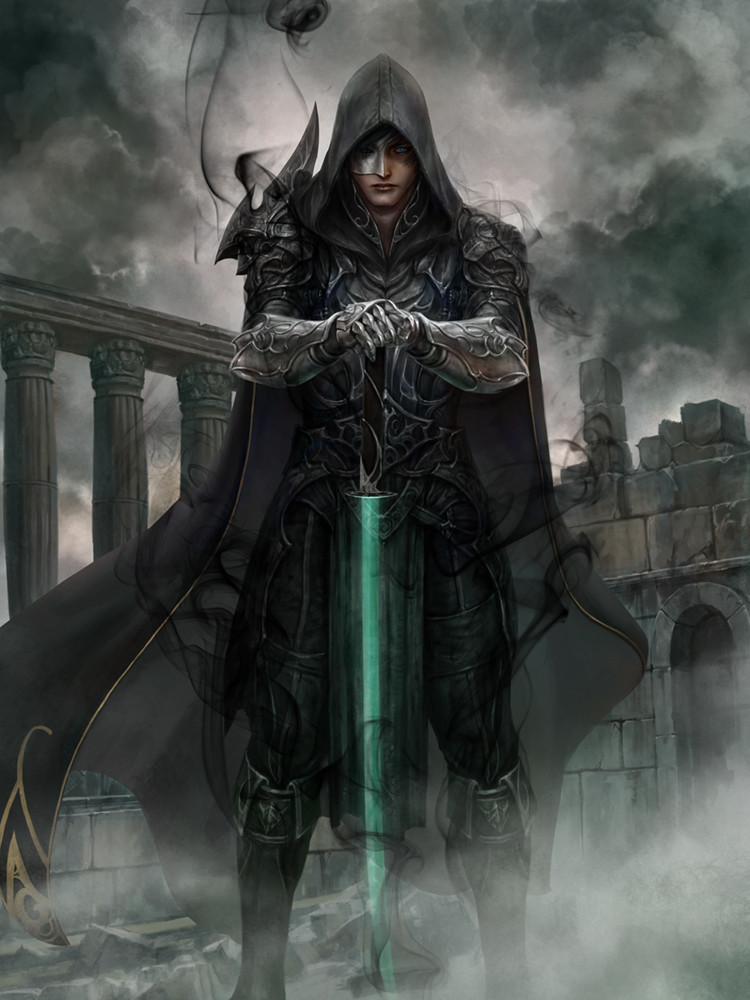













Study of the Eldritch Archer
An eldritch archer forgoes the typical focus on melee combat to instead deliver spells through ranged weapons such as bows or crossbows. They become masters of spellstriking, able to cast all manner of dangerous spells through their attacks.
Ranged Spellstrike
At 3rd level, you learn to perform spellstrike attacks through ranged weapons. Your spellstrike feature is modified to
additionally allow spellcasting with
ranged weapon attacks.
Mystical Barrage
Beginning at 3rd level, you can use arcane energies to launch multiple projectiles in one attack. When you use your action to make an attack with a ranged weapon, you may expend 1 AP to make one additional attack against the target creature as part of your action.
After using focused barrage, all your subsequent attacks must target that same creature until the end of your turn. This feature cannot be performed if you previously made an attack roll against a different creature on your current turn.
Arcane Projectiles
Beginning at 7th level, you can imbue your ammunition with elemental energies. Doing so requires 1 minute of time per piece of ammunition enchanted. Projectiles enchanted in this manner do an extra 1d6 fire, cold, lightning, acid, or poison
damage (your choice at the time of enchantment) when used
by the magus and lose their enchantment after being
used for an attack.
Stunning Shot
At 11th level, you become adept at targeting
opponents weak points with magical energies. Once
per round, when you hit a creature with a ranged
weapon attack you may expend 2 AP to attempt a
stunning shot. The target must succeed on a
Constitution saving throw against your spell save DC or
be stunned until the end of your next turn.
Perfected Spellstrike
At 15th level, you expand the repertoire of spells
you can deliver with your ranged attacks. When
you perform spellstrike with a ranged weapon,
you can choose to allow the spell to affect its
normal area instead of a single target.
The target of your projectile may be a
creature or a specific point in the environment.
If your target is a creature, they are considered
within the area of the spell on a hit and have
disadvantage on the spell's initial saving throw,
if applicable. If your target is a point in the
environment, your attack automatically hits.
Spells with an area of effect have their
point of origin where your projectile strikes.
For cone, cube, and line shaped spells, the
areas extend in the direction opposite of you.
The ranges of other spells (without a defined
area of effect) are similarly determined from
where your projectile strikes.
If your attack misses a creature, the DM
determines a reasonable location the
projectile lands and thus the location of the
spell's point of origin.
If you make a critical hit on a spellstrike
using a spell with an area of effect, only
the targeted creature takes critical
damage from the spell and weapon
attack. All other creatures in the spell's
area take normal damage from the spell.



















Study of the Vanquisher
Unlike other magus studies, vanquishers study the will of the divine to fuel magical attacks. Much like paladins and clerics, vanquishers are often sworn to the service of a diety and spend their lives in pursuit of heavenly knowledge.
Divine Magic
At 3rd level, you begin calling upon divine powers to fuel your magic. You gain proficiency in religion or another magus class skill if already proficient.
In addition, when you learn a magus spell, you can choose the new spell from the paladin spell list or the magus spell list. These are magus spells for you.
Restorative Strike
Beginning at 3rd level, you can unleash bursts of divine healing with your strikes. When you hit a creature with a melee weapon attack, you may spend AP to regain hit points equal to 1d6 per AP spent plus your intelligence modifier. You may spend a number of AP up to half your magus level (rounded down) to use this feature.
Student of the Heavens
At 7th level, you have learned much about the
creatures that inhabit the many planes through your
studies. You have advantage on intelligence ability checks
to recall information about aberrations, celestials, elementals, fey, fiends, and undead.
Possible information known about these creatures includes their abilities, strongest/weakest ability scores, etc. in addition to general facts about a creature's behavior and history.
Spiritual Devotion
Beginning at 11th level, your dedication to heavenly principles empowers you with holy protection. When you take damage, you may use your reaction and spend 2 AP to give yourself resistance to the triggering damage.
Blessed Slayer
At 15h level, you have expanded your knowledge of the planes and the creatures within them and are prepared to end those who defy the holy standards of your worship. You have advantage on melee attack rolls against creatures of the following types: aberrations, celestials, elementals, fey, fiends, and undead.
In addition, those creatures have disadvantage on intelligence, wisdom, and charisma saving throws to resist your spells and features.
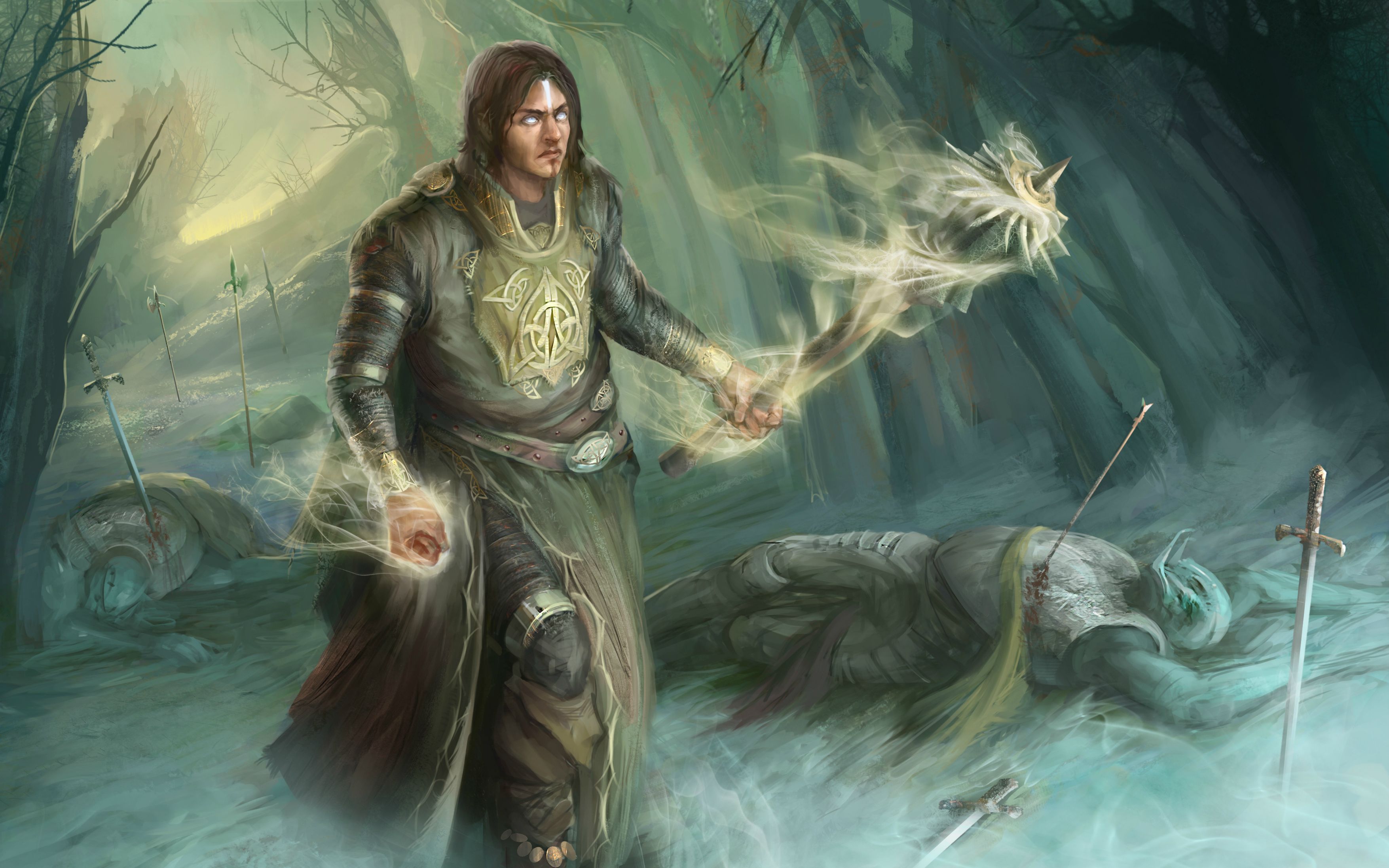














Study of the Stygian
Some magi, known as stygians, learn to blend shadowfell magic with their martial training, letting them stay unnoticed as they take down foes.
Shadow Weaver
At 3rd level, you learn to guide shadows to magically conceal yourself. You gain proficiency in stealth (or another magus class skill if already proficient). Whenever you make a stealth check, you may add your Intelligence modifier to the roll.
Additionally, whenever you cast a spell, you may spend 1 AP to cast it silently, without verbal components.
Arcane Cloak
Beginning at 3rd level, you use
arcane energy to render yourself
briefly invisible. When you move on
your turn, you may spend 1 AP to
become invisible until the
beginning of your next turn. This
invisibility ends early when you
attack or cast a spell.
Creatures who know you are
present may make a perception
check on their turn against your spell
save DC to know your location (no
action required). On a success, that
creature may attack you at
disadvantage. Creatures whom you
attacked on your last turn have
advantage on the perception check.
You may use arcane cloak out of
combat when turns are not closely
tracked. In these situations,
arcane cloak lasts 6 seconds
(unless it ends early). You may
spend additional AP to extend the
invisibility by an additional 6
seconds per AP spent.
Void Sight
Beginning at 7th level, your
expertise with shadow allows you to
see clearly through darkness and
partially see through invisibility. You
gain darkvision for 60 feet, and can
see through magical darkness. If you
already have darkvision, the range
increases by 30 feet. Additionally, you
can see the vague outline of invisible
creatures and objects within 30 feet of you,
allowing you to know their location. Your attacks
against invisible creatures are still made with
disadvantage.
Lingering Shadow
Beginning at 11th level, shadows cling to your form even when you are no longer invisible. Whenever the invisibility from your arcane cloak ends early, attacks against you have disadvantage until the beginning of your next turn.
Nightblade's Strike
Beginning at 15th level, your mastery of stealth and arcana allow you to deliver devastating strikes suffused with harmful shadowfell magic. Once per round, when you have advantage on an attack roll, you may spend 3 AP to automatically hit before you make the attack roll. You may still roll to attack after choosing to perform this feature to determine if you make a critical hit.
An attack performed this way deals an additional 2d6 necrotic damage a number of times equal to your intelligence modifier (for example, if you have +3 as your intelligence modifier, you deal an additional 6d6 necrotic damage).
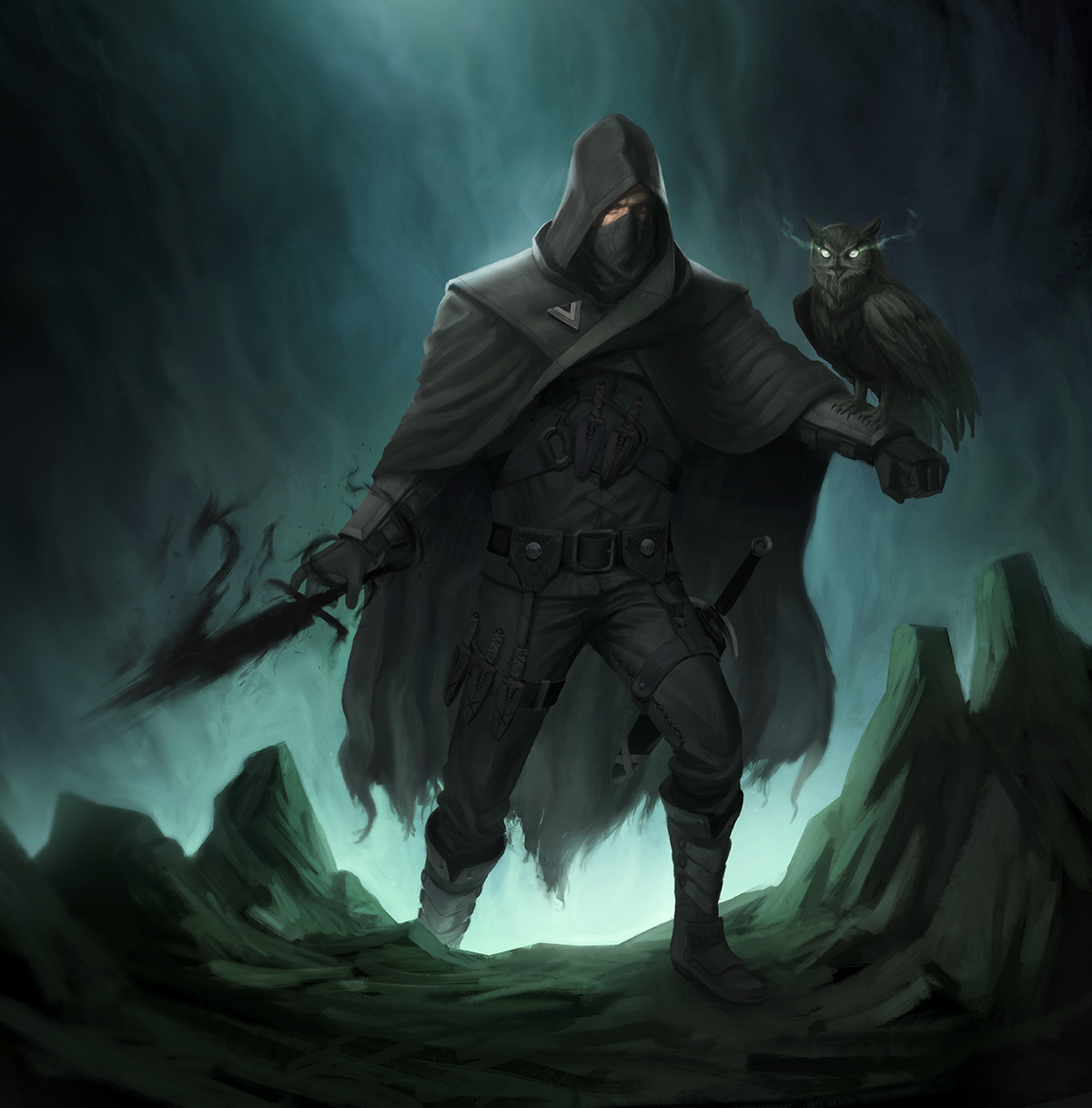

















Study of the Primagus
While many magi learn magic through formal study, there are those who draw power from natural sources. These magi are often wise people or shamans for tribal groups who use their knowledge of nature and tribal tradition to produce magic and fight alongside their fellow warriors.
Natural Magic
At 3rd level, you begin using your knowledge of nature and its creatures to power your magic. You gain proficiency in nature (or another magus class skill if already proficient).
In addition, when your Spellcasting feature lets you learn a magus spell, you can choose the new spell from the ranger spell list or the magus spell list. These are magus spells for you.
Boon of the Hunt
Beginning at 3rd level, your arcane blows inspire ancestor warrior spirits to empower your war party. When you hit a creature with a weapon attack, you may spend 1 AP to grant an ally within 10ft of yourself advantage on attack rolls until the beginning of your next turn.
Feral Skill
At 7th level, you infuse your martial capabilities with passed-down techniques learned anciently from the wild. Choose one of the following options.
Fortitude of the Bear
Once per short rest, when a creature hits you and deals damage, you may use your reaction to take only
half as much damage.
Agility of the Elk
Once per short rest, when you fail a dexterity saving throw, you may use your reaction to succeed instead.
Ferocity of the Wolf
Once per short rest, when you hit a creature, you may choose to roll your weapon damage die twice and add them together for that attack.
Shrewdness of the Owl
Once per short rest, when you miss a melee attack roll, you may choose to reroll the attack.
Nerve of the Hawk
Once per short rest, if you fail a check to maintain concentration on a spell, you may choose to succeed instead.
Empowering Ritual
At 11th level, you have created a ritual to bolster your allies before a fight. Once per long rest, you and up to 10 allies may participate in the ritual which takes 10 minutes. This can be done as part of a long or short rest. Each creature that participates gains temporary hit points equal to half your magus level (rounded down) plus your intelligence modifier.
Wild Arcana
At 15th level, you begin applying arcane power to your nature-inspired martial techniques. Your may now use your chosen feral skill technique more than once per short rest, however, every subsequent use after the first requires spending AP.
Additional uses of Ferocity of the Wolf require 1 AP,
all other techniques require 2 AP.












Magus Spell List
Cantrips
- Acid Splash
- Blade Ward
- Booming Blade
- Chill Touch
- Control Flames
- Dancing Lights
- Fire Bolt
- Frostbite
- Green-flame Blade
- Gust
- Light
- Lightning Lure
- Mage Hand
- Mending
- Mold Earth
- Prestidigitation
- Produce Flame
- Ray of Frost
- Resistance
- Shape Water
- Shocking Grasp
- Sword Burst
- True Strike
1st Level
- Absorb Elements
- Burning Hands
- Cause Fear
- Chromatic Orb
- Color Spray
- Comprehend Languages
- Detect Magic
- Disguise Self
- Expeditious Retreat
- Feather Fall
- Find Familiar
- Grease
- Hideous Laughter
- Ice Knife
- Identify
- Jump
- Magic Missile
- Shield
- Silent Image
- Sleep
- Thunderwave
2nd Level
- Acid Arrow
- Aganazzar's Scorcher
- Alter Self
- Blindness/Deafness
- Blur
- Darkness
- Darkvision
- Detect Thoughts
- Earthbind
- Enlarge/Reduce
- Flaming Sphere
- Gust of Wind
- Hold Person
- Invisibility
- Magic Weapon
- Maximilian's Earthen Grasp
- Mind Spike
- Mirror Image
- Misty Step
- Phantasmal Force
- Ray of Enfeeblement
- Scorching Ray
- Shadow Blade
- Shatter
- See Invisibility
- Spider Climb
- Suggestion
- Web
3rd Level
- Blink
- Clairvoyance
- Counterspell
- Dispel Magic
- Elemental Weapon
- Enemies Abound
- Erupting Earth
- Fear
- Fireball
- Fly
- Gaseous Form
- Haste
- Hypnotic Pattern
- Lightning Bolt
- Major Image
- Protection from Energy
- Sending
- Sleet Storm
- Slow
- Spirit Shroud
- Thunder Step
- Tidal Wave
- Tiny Hut
- Tongues
- Wall of Sand
- Wall of Water
- Water Breathing
4th Level
- Arcane Eye
- Banishment
- Blight
- Charm Monster
- Confusion
- Control Water
- Dimension Door
- Elemental Bane
- Fire Shield
- Greater Invisibility
- Ice Storm
- Locate Creature
- Phantasmal Killer
- Resilient Sphere
- Secret Chest
- Sickening Radiance
- Stone Shape
- Stoneskin
- Storm Sphere
- Vitriolic Sphere
- Wall of Fire
- Watery Sphere
5th Level
- Arcane Hand
- Cloudkill
- Cone of Cold
- Control Winds
- Dawn
- Dominate Person
- Far Step
- Hold Monster
- Immolation
- Legend Lore
- Mislead
- Modify Memory
- Negative Energy Flood
- Scrying
- Seeming
- Steel Wind Strike
- Synpatic Static
- Telepathic Bond
- Transmute Rock
- Wall of Force
- Wall of Light
- Wall of Stone
Multiclassing
Prerequisites. To qualify for multiclassing with the
Magus class, you must meet these prerequisites: 13
Intelligence and 13 Strength or Dexterity.
Proficiencies. When you multiclass into the Magus
class, you gain the following proficiencies: Simple
weapons, martial weapons, light armor, medium armor.
Spell Slots. You add half your Magus levels (rounded
down) to determine multiclass spell slots.


















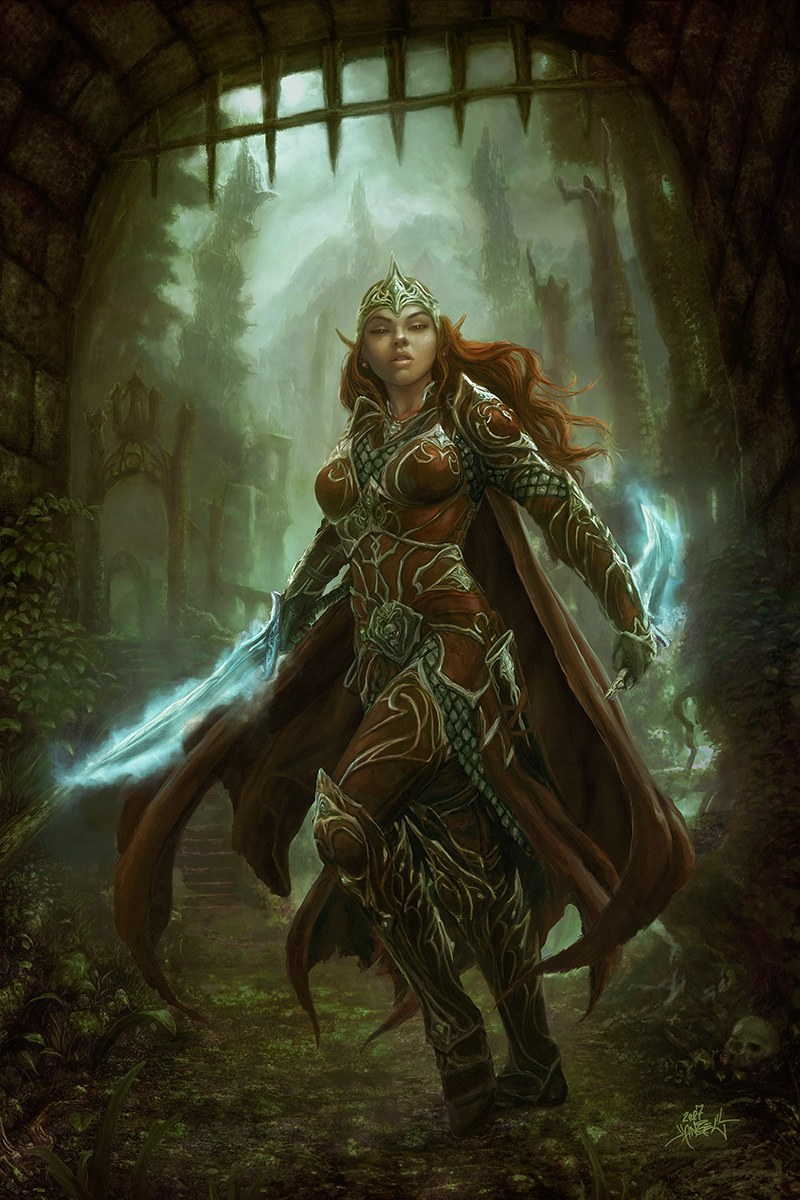
The Magus
A half-caster class for those who can't choose between might and magic. Bring sword and spells to bear against your enemies with seven Magus schools: the Warmage, Magister, Hexcrafter, Eldritch Archer, Vanquisher,
Stygian, and Primagus.
Art Credits
Page 2: Broken Mirrors by theDURRRRIAN
Page 5: Regongar by OwlCat Games
Page 6: Dela C by Astri-Lohne
Page 7: Battlemage by Grzegorz Rutkowski
Page 8: MurderLoad by Mansik Yang
Page 9: Seldarine Dedicate by Howard Lyon
Page 10: Paladin by TheNightbringer
Page 11: Ridill by Glassmachine
Page 12: Forest Defender by S. Horoszko
Page 13: Fire Sword by Dmitry Grebenkov
Page 14: Spellsword by TheFirstAngel
See Dragonshard's GM Binder profile for more homebrew classes inspired by Pathfinder.